A Critical Analysis of Crime Prevention Approaches for Modern Policing
VerifiedAdded on 2023/06/18
|8
|2143
|351
Essay
AI Summary
This essay provides a critical analysis of crime prevention approaches developed to aid police in the 21st century. It begins by defining crime and its essential elements before delving into various crime prevention strategies, including primary, secondary, and tertiary prevention. The essay examines developmental and situational crime prevention, highlighting the importance of addressing early risk factors and modifying physical environments to reduce criminal opportunities. Furthermore, it discusses practical approaches such as patrolling, community policing, and partnerships with governmental agencies and community organizations. The analysis emphasizes how these strategies aim to deter crime, maintain law and order, and foster trust between the police and the communities they serve, ultimately concluding that a multifaceted approach is essential for effective crime reduction.
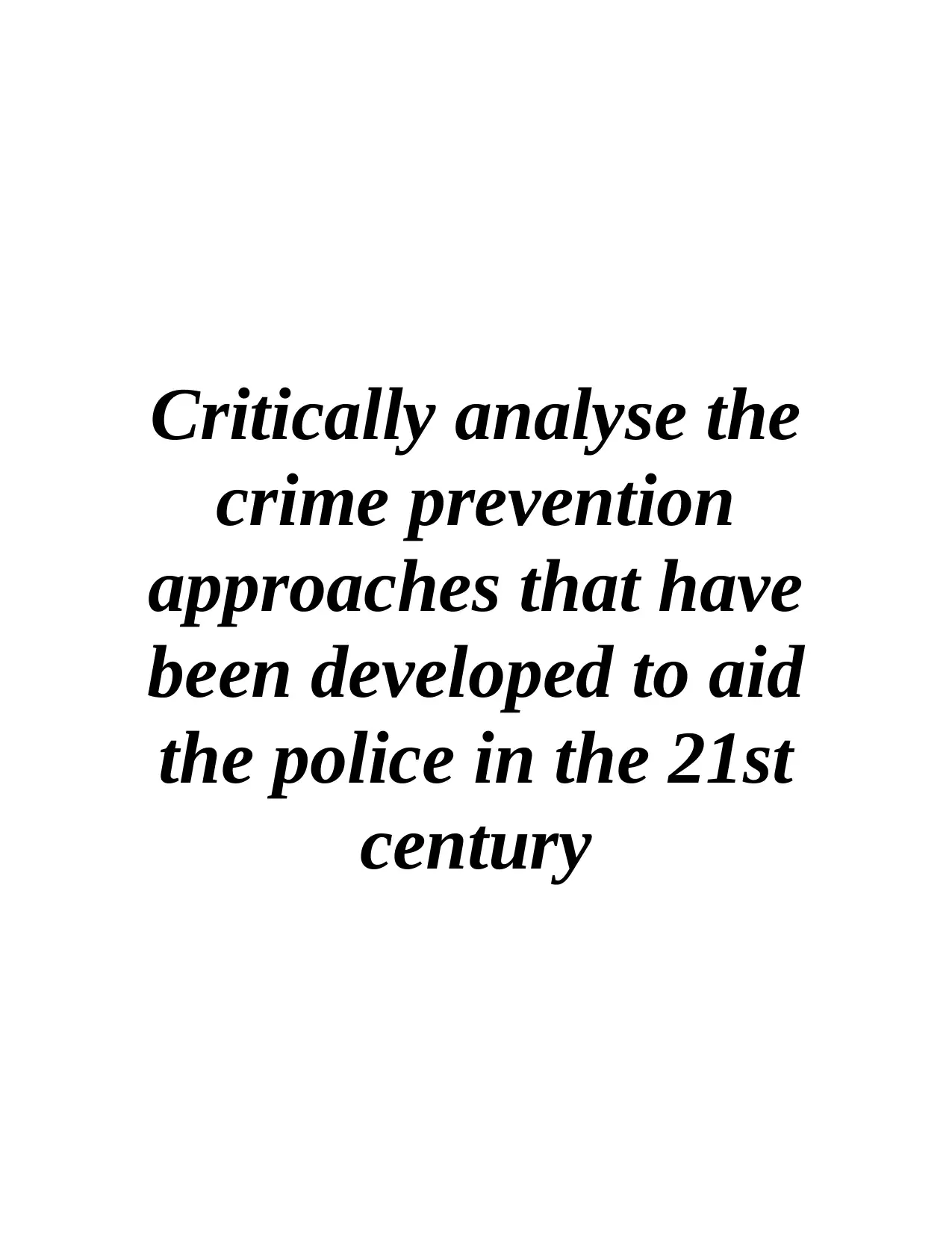
Critically analyse the
crime prevention
approaches that have
been developed to aid
the police in the 21st
century
crime prevention
approaches that have
been developed to aid
the police in the 21st
century
Paraphrase This Document
Need a fresh take? Get an instant paraphrase of this document with our AI Paraphraser

Table of Contents
INTRODUCTION ..........................................................................................................................3
MAIN BODY ..................................................................................................................................3
CONCLUSION................................................................................................................................7
REFERENCES................................................................................................................................8
INTRODUCTION ..........................................................................................................................3
MAIN BODY ..................................................................................................................................3
CONCLUSION................................................................................................................................7
REFERENCES................................................................................................................................8
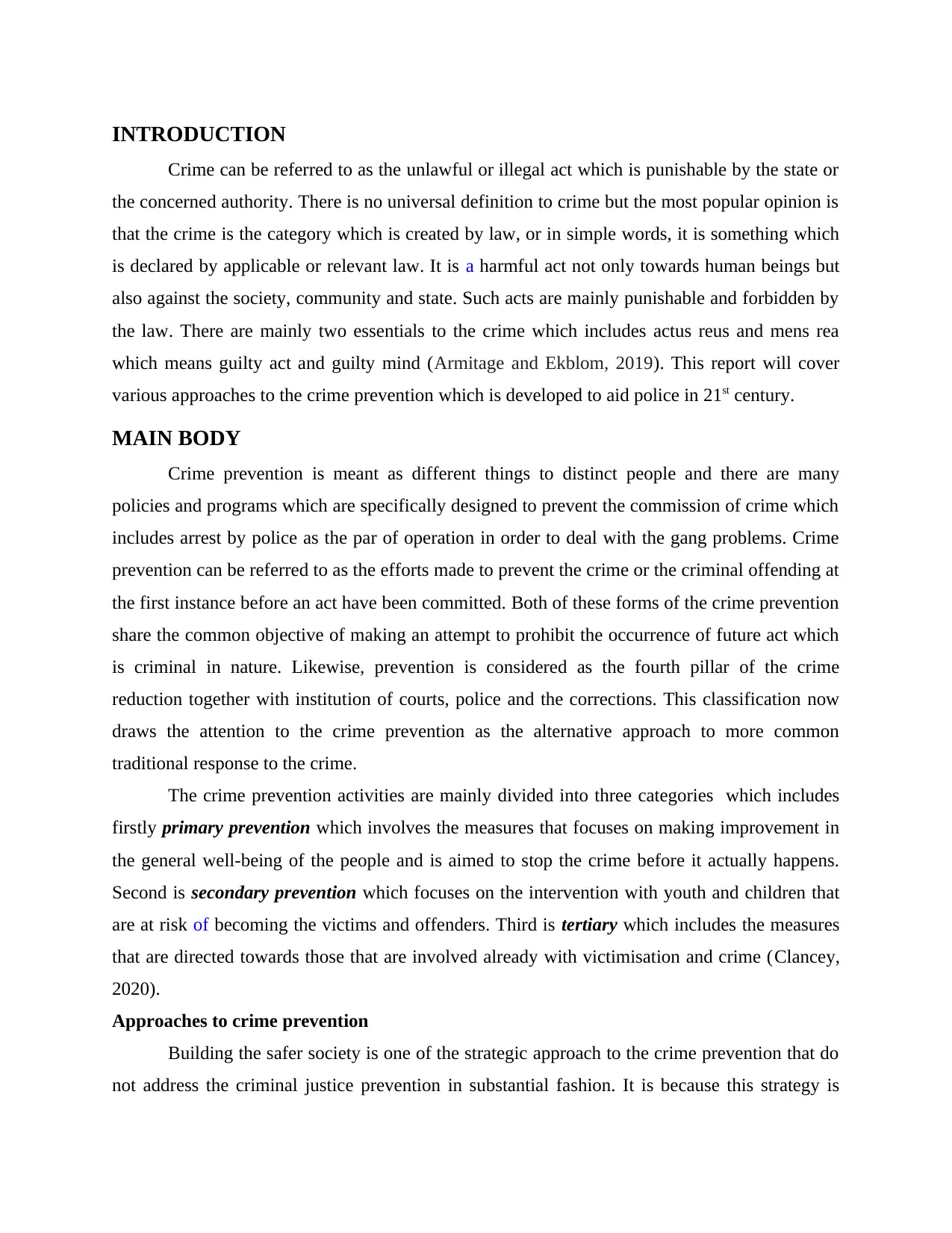
INTRODUCTION
Crime can be referred to as the unlawful or illegal act which is punishable by the state or
the concerned authority. There is no universal definition to crime but the most popular opinion is
that the crime is the category which is created by law, or in simple words, it is something which
is declared by applicable or relevant law. It is a harmful act not only towards human beings but
also against the society, community and state. Such acts are mainly punishable and forbidden by
the law. There are mainly two essentials to the crime which includes actus reus and mens rea
which means guilty act and guilty mind (Armitage and Ekblom, 2019). This report will cover
various approaches to the crime prevention which is developed to aid police in 21st century.
MAIN BODY
Crime prevention is meant as different things to distinct people and there are many
policies and programs which are specifically designed to prevent the commission of crime which
includes arrest by police as the par of operation in order to deal with the gang problems. Crime
prevention can be referred to as the efforts made to prevent the crime or the criminal offending at
the first instance before an act have been committed. Both of these forms of the crime prevention
share the common objective of making an attempt to prohibit the occurrence of future act which
is criminal in nature. Likewise, prevention is considered as the fourth pillar of the crime
reduction together with institution of courts, police and the corrections. This classification now
draws the attention to the crime prevention as the alternative approach to more common
traditional response to the crime.
The crime prevention activities are mainly divided into three categories which includes
firstly primary prevention which involves the measures that focuses on making improvement in
the general well-being of the people and is aimed to stop the crime before it actually happens.
Second is secondary prevention which focuses on the intervention with youth and children that
are at risk of becoming the victims and offenders. Third is tertiary which includes the measures
that are directed towards those that are involved already with victimisation and crime (Clancey,
2020).
Approaches to crime prevention
Building the safer society is one of the strategic approach to the crime prevention that do
not address the criminal justice prevention in substantial fashion. It is because this strategy is
Crime can be referred to as the unlawful or illegal act which is punishable by the state or
the concerned authority. There is no universal definition to crime but the most popular opinion is
that the crime is the category which is created by law, or in simple words, it is something which
is declared by applicable or relevant law. It is a harmful act not only towards human beings but
also against the society, community and state. Such acts are mainly punishable and forbidden by
the law. There are mainly two essentials to the crime which includes actus reus and mens rea
which means guilty act and guilty mind (Armitage and Ekblom, 2019). This report will cover
various approaches to the crime prevention which is developed to aid police in 21st century.
MAIN BODY
Crime prevention is meant as different things to distinct people and there are many
policies and programs which are specifically designed to prevent the commission of crime which
includes arrest by police as the par of operation in order to deal with the gang problems. Crime
prevention can be referred to as the efforts made to prevent the crime or the criminal offending at
the first instance before an act have been committed. Both of these forms of the crime prevention
share the common objective of making an attempt to prohibit the occurrence of future act which
is criminal in nature. Likewise, prevention is considered as the fourth pillar of the crime
reduction together with institution of courts, police and the corrections. This classification now
draws the attention to the crime prevention as the alternative approach to more common
traditional response to the crime.
The crime prevention activities are mainly divided into three categories which includes
firstly primary prevention which involves the measures that focuses on making improvement in
the general well-being of the people and is aimed to stop the crime before it actually happens.
Second is secondary prevention which focuses on the intervention with youth and children that
are at risk of becoming the victims and offenders. Third is tertiary which includes the measures
that are directed towards those that are involved already with victimisation and crime (Clancey,
2020).
Approaches to crime prevention
Building the safer society is one of the strategic approach to the crime prevention that do
not address the criminal justice prevention in substantial fashion. It is because this strategy is
⊘ This is a preview!⊘
Do you want full access?
Subscribe today to unlock all pages.

Trusted by 1+ million students worldwide
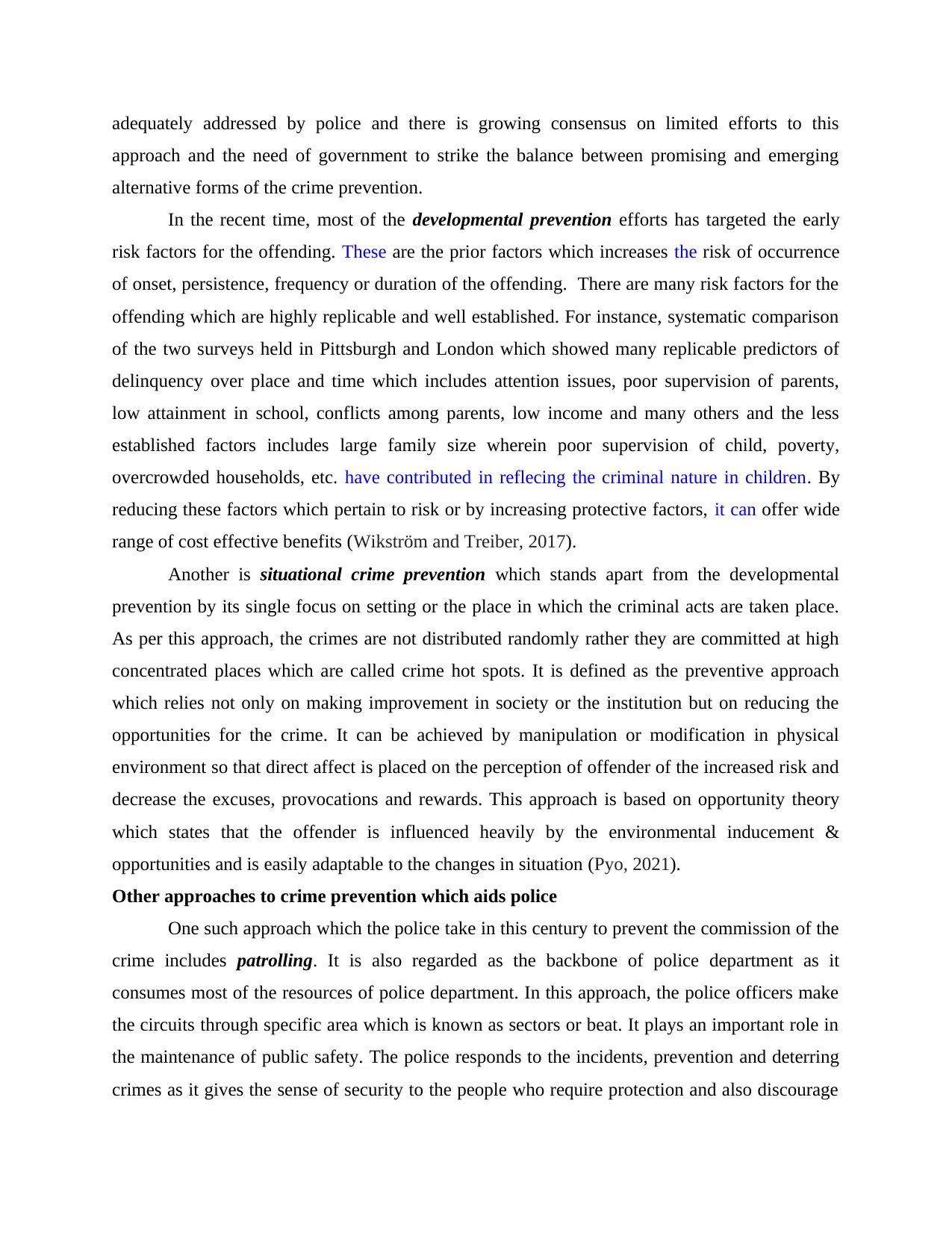
adequately addressed by police and there is growing consensus on limited efforts to this
approach and the need of government to strike the balance between promising and emerging
alternative forms of the crime prevention.
In the recent time, most of the developmental prevention efforts has targeted the early
risk factors for the offending. These are the prior factors which increases the risk of occurrence
of onset, persistence, frequency or duration of the offending. There are many risk factors for the
offending which are highly replicable and well established. For instance, systematic comparison
of the two surveys held in Pittsburgh and London which showed many replicable predictors of
delinquency over place and time which includes attention issues, poor supervision of parents,
low attainment in school, conflicts among parents, low income and many others and the less
established factors includes large family size wherein poor supervision of child, poverty,
overcrowded households, etc. have contributed in reflecing the criminal nature in children. By
reducing these factors which pertain to risk or by increasing protective factors, it can offer wide
range of cost effective benefits (Wikström and Treiber, 2017).
Another is situational crime prevention which stands apart from the developmental
prevention by its single focus on setting or the place in which the criminal acts are taken place.
As per this approach, the crimes are not distributed randomly rather they are committed at high
concentrated places which are called crime hot spots. It is defined as the preventive approach
which relies not only on making improvement in society or the institution but on reducing the
opportunities for the crime. It can be achieved by manipulation or modification in physical
environment so that direct affect is placed on the perception of offender of the increased risk and
decrease the excuses, provocations and rewards. This approach is based on opportunity theory
which states that the offender is influenced heavily by the environmental inducement &
opportunities and is easily adaptable to the changes in situation (Pyo, 2021).
Other approaches to crime prevention which aids police
One such approach which the police take in this century to prevent the commission of the
crime includes patrolling. It is also regarded as the backbone of police department as it
consumes most of the resources of police department. In this approach, the police officers make
the circuits through specific area which is known as sectors or beat. It plays an important role in
the maintenance of public safety. The police responds to the incidents, prevention and deterring
crimes as it gives the sense of security to the people who require protection and also discourage
approach and the need of government to strike the balance between promising and emerging
alternative forms of the crime prevention.
In the recent time, most of the developmental prevention efforts has targeted the early
risk factors for the offending. These are the prior factors which increases the risk of occurrence
of onset, persistence, frequency or duration of the offending. There are many risk factors for the
offending which are highly replicable and well established. For instance, systematic comparison
of the two surveys held in Pittsburgh and London which showed many replicable predictors of
delinquency over place and time which includes attention issues, poor supervision of parents,
low attainment in school, conflicts among parents, low income and many others and the less
established factors includes large family size wherein poor supervision of child, poverty,
overcrowded households, etc. have contributed in reflecing the criminal nature in children. By
reducing these factors which pertain to risk or by increasing protective factors, it can offer wide
range of cost effective benefits (Wikström and Treiber, 2017).
Another is situational crime prevention which stands apart from the developmental
prevention by its single focus on setting or the place in which the criminal acts are taken place.
As per this approach, the crimes are not distributed randomly rather they are committed at high
concentrated places which are called crime hot spots. It is defined as the preventive approach
which relies not only on making improvement in society or the institution but on reducing the
opportunities for the crime. It can be achieved by manipulation or modification in physical
environment so that direct affect is placed on the perception of offender of the increased risk and
decrease the excuses, provocations and rewards. This approach is based on opportunity theory
which states that the offender is influenced heavily by the environmental inducement &
opportunities and is easily adaptable to the changes in situation (Pyo, 2021).
Other approaches to crime prevention which aids police
One such approach which the police take in this century to prevent the commission of the
crime includes patrolling. It is also regarded as the backbone of police department as it
consumes most of the resources of police department. In this approach, the police officers make
the circuits through specific area which is known as sectors or beat. It plays an important role in
the maintenance of public safety. The police responds to the incidents, prevention and deterring
crimes as it gives the sense of security to the people who require protection and also discourage
Paraphrase This Document
Need a fresh take? Get an instant paraphrase of this document with our AI Paraphraser
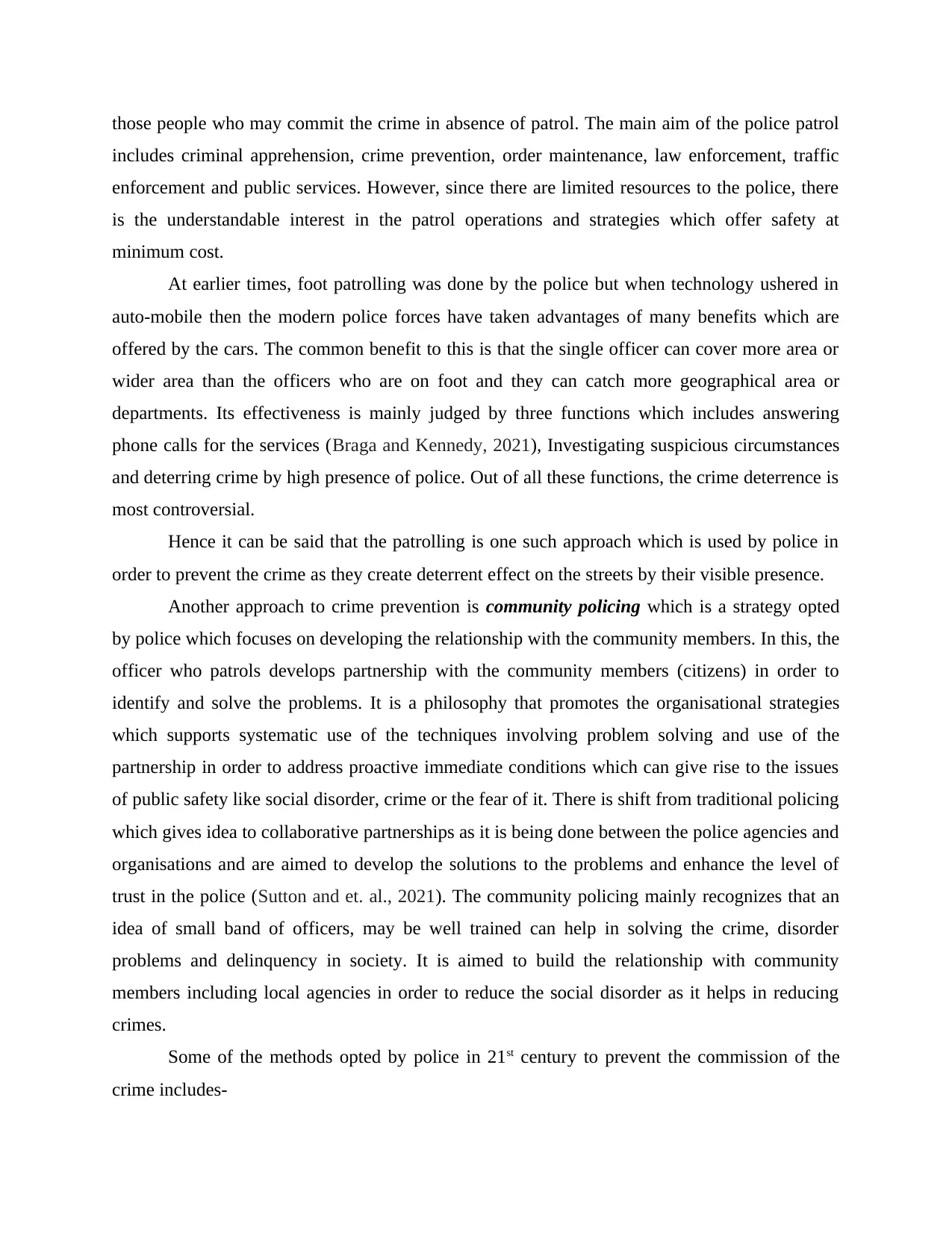
those people who may commit the crime in absence of patrol. The main aim of the police patrol
includes criminal apprehension, crime prevention, order maintenance, law enforcement, traffic
enforcement and public services. However, since there are limited resources to the police, there
is the understandable interest in the patrol operations and strategies which offer safety at
minimum cost.
At earlier times, foot patrolling was done by the police but when technology ushered in
auto-mobile then the modern police forces have taken advantages of many benefits which are
offered by the cars. The common benefit to this is that the single officer can cover more area or
wider area than the officers who are on foot and they can catch more geographical area or
departments. Its effectiveness is mainly judged by three functions which includes answering
phone calls for the services (Braga and Kennedy, 2021), Investigating suspicious circumstances
and deterring crime by high presence of police. Out of all these functions, the crime deterrence is
most controversial.
Hence it can be said that the patrolling is one such approach which is used by police in
order to prevent the crime as they create deterrent effect on the streets by their visible presence.
Another approach to crime prevention is community policing which is a strategy opted
by police which focuses on developing the relationship with the community members. In this, the
officer who patrols develops partnership with the community members (citizens) in order to
identify and solve the problems. It is a philosophy that promotes the organisational strategies
which supports systematic use of the techniques involving problem solving and use of the
partnership in order to address proactive immediate conditions which can give rise to the issues
of public safety like social disorder, crime or the fear of it. There is shift from traditional policing
which gives idea to collaborative partnerships as it is being done between the police agencies and
organisations and are aimed to develop the solutions to the problems and enhance the level of
trust in the police (Sutton and et. al., 2021). The community policing mainly recognizes that an
idea of small band of officers, may be well trained can help in solving the crime, disorder
problems and delinquency in society. It is aimed to build the relationship with community
members including local agencies in order to reduce the social disorder as it helps in reducing
crimes.
Some of the methods opted by police in 21st century to prevent the commission of the
crime includes-
includes criminal apprehension, crime prevention, order maintenance, law enforcement, traffic
enforcement and public services. However, since there are limited resources to the police, there
is the understandable interest in the patrol operations and strategies which offer safety at
minimum cost.
At earlier times, foot patrolling was done by the police but when technology ushered in
auto-mobile then the modern police forces have taken advantages of many benefits which are
offered by the cars. The common benefit to this is that the single officer can cover more area or
wider area than the officers who are on foot and they can catch more geographical area or
departments. Its effectiveness is mainly judged by three functions which includes answering
phone calls for the services (Braga and Kennedy, 2021), Investigating suspicious circumstances
and deterring crime by high presence of police. Out of all these functions, the crime deterrence is
most controversial.
Hence it can be said that the patrolling is one such approach which is used by police in
order to prevent the crime as they create deterrent effect on the streets by their visible presence.
Another approach to crime prevention is community policing which is a strategy opted
by police which focuses on developing the relationship with the community members. In this, the
officer who patrols develops partnership with the community members (citizens) in order to
identify and solve the problems. It is a philosophy that promotes the organisational strategies
which supports systematic use of the techniques involving problem solving and use of the
partnership in order to address proactive immediate conditions which can give rise to the issues
of public safety like social disorder, crime or the fear of it. There is shift from traditional policing
which gives idea to collaborative partnerships as it is being done between the police agencies and
organisations and are aimed to develop the solutions to the problems and enhance the level of
trust in the police (Sutton and et. al., 2021). The community policing mainly recognizes that an
idea of small band of officers, may be well trained can help in solving the crime, disorder
problems and delinquency in society. It is aimed to build the relationship with community
members including local agencies in order to reduce the social disorder as it helps in reducing
crimes.
Some of the methods opted by police in 21st century to prevent the commission of the
crime includes-

Encouraging members of community to help in the prevention of crime by way of
providing advice by way of encouraging the neighbourhood watch groups or talking to
the students.
Increasing the patrolling in order to increase presence in streets.
Creating the team of officers in order to carry out the community policing in the
designated neighbourhood.
Partnership with the organisations such as community members, governmental agencies,
media, non profit service providers and many others.
By taking this approach, the police can not only win the trust of the citizens but also built
the favourable view in the minds of residents regarding the local police. They will also be able
to take the accurate information from the residents in respect of criminal activity in community
and have better understanding about needs of the citizens and also their expectation with police
(Monchuk and Clancey, 2021).
Another approach for the crime prevention which can aid police in today's time is
partnerships wherein the police departments may partner with many other governmental
agencies in order to identify the community concerns and bring alternative solutions to it. These
agencies include prosecutors, legislative bodies, probation and parole, schools, public works
department and many others. With the help of these partnerships, the police identifies the
community concerns. Media plays an important role in communicating with the people as they
assist in publicizing the concerns of community and the solutions available like services from
community agencies and government or the new codes or laws enacted. It aids in placing
significant impact on the perception of people for crime problems, police and the fear of crime
(Miller, 2019).
Hence, it can be said that there are many approaches to crime prevention which aid police
in reducing the number of criminal offences. These are aimed to create deterrent effect on people
so that the rate of crime is decreased and also the trust of people in the police is gained.
providing advice by way of encouraging the neighbourhood watch groups or talking to
the students.
Increasing the patrolling in order to increase presence in streets.
Creating the team of officers in order to carry out the community policing in the
designated neighbourhood.
Partnership with the organisations such as community members, governmental agencies,
media, non profit service providers and many others.
By taking this approach, the police can not only win the trust of the citizens but also built
the favourable view in the minds of residents regarding the local police. They will also be able
to take the accurate information from the residents in respect of criminal activity in community
and have better understanding about needs of the citizens and also their expectation with police
(Monchuk and Clancey, 2021).
Another approach for the crime prevention which can aid police in today's time is
partnerships wherein the police departments may partner with many other governmental
agencies in order to identify the community concerns and bring alternative solutions to it. These
agencies include prosecutors, legislative bodies, probation and parole, schools, public works
department and many others. With the help of these partnerships, the police identifies the
community concerns. Media plays an important role in communicating with the people as they
assist in publicizing the concerns of community and the solutions available like services from
community agencies and government or the new codes or laws enacted. It aids in placing
significant impact on the perception of people for crime problems, police and the fear of crime
(Miller, 2019).
Hence, it can be said that there are many approaches to crime prevention which aid police
in reducing the number of criminal offences. These are aimed to create deterrent effect on people
so that the rate of crime is decreased and also the trust of people in the police is gained.
⊘ This is a preview!⊘
Do you want full access?
Subscribe today to unlock all pages.

Trusted by 1+ million students worldwide
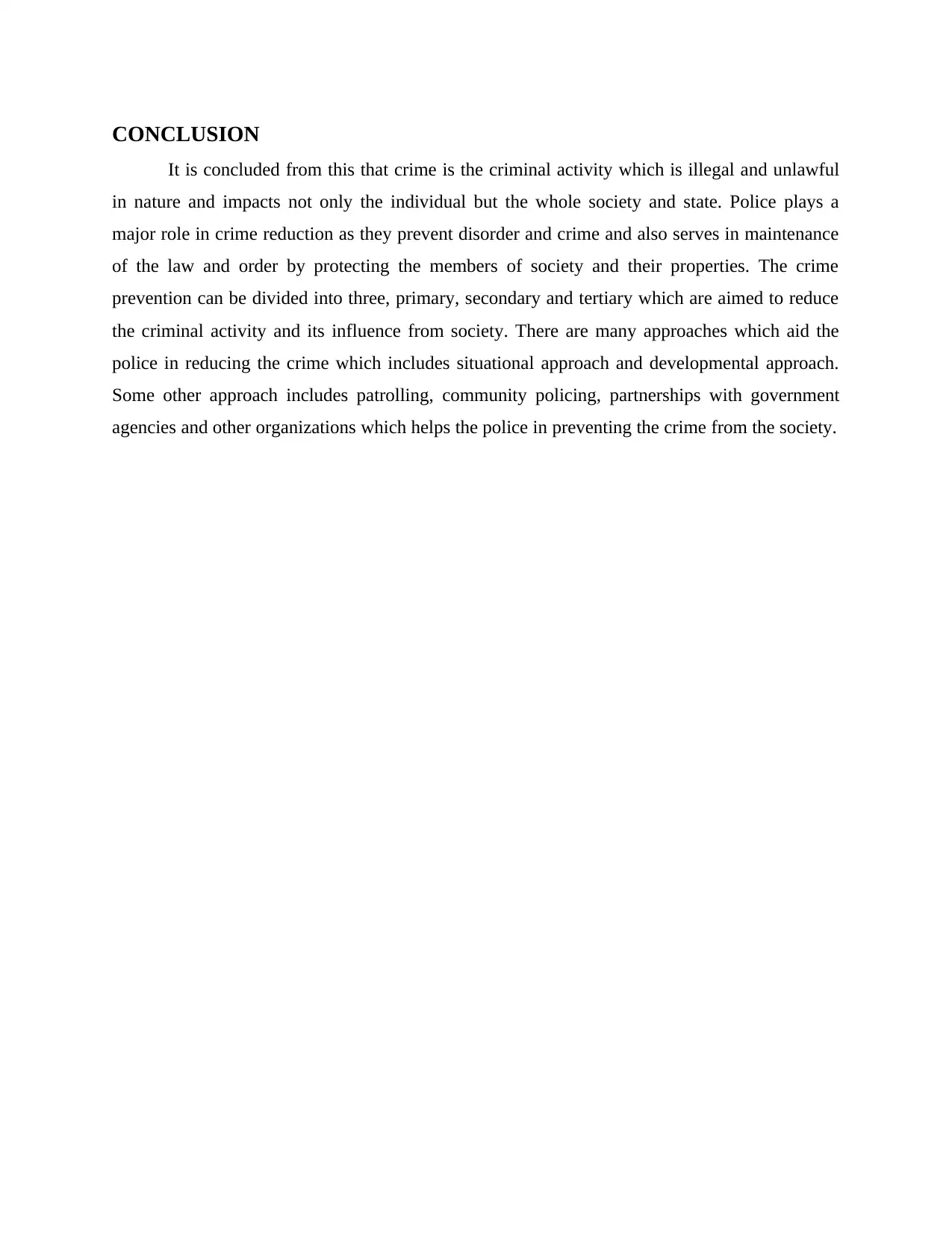
CONCLUSION
It is concluded from this that crime is the criminal activity which is illegal and unlawful
in nature and impacts not only the individual but the whole society and state. Police plays a
major role in crime reduction as they prevent disorder and crime and also serves in maintenance
of the law and order by protecting the members of society and their properties. The crime
prevention can be divided into three, primary, secondary and tertiary which are aimed to reduce
the criminal activity and its influence from society. There are many approaches which aid the
police in reducing the crime which includes situational approach and developmental approach.
Some other approach includes patrolling, community policing, partnerships with government
agencies and other organizations which helps the police in preventing the crime from the society.
It is concluded from this that crime is the criminal activity which is illegal and unlawful
in nature and impacts not only the individual but the whole society and state. Police plays a
major role in crime reduction as they prevent disorder and crime and also serves in maintenance
of the law and order by protecting the members of society and their properties. The crime
prevention can be divided into three, primary, secondary and tertiary which are aimed to reduce
the criminal activity and its influence from society. There are many approaches which aid the
police in reducing the crime which includes situational approach and developmental approach.
Some other approach includes patrolling, community policing, partnerships with government
agencies and other organizations which helps the police in preventing the crime from the society.
Paraphrase This Document
Need a fresh take? Get an instant paraphrase of this document with our AI Paraphraser
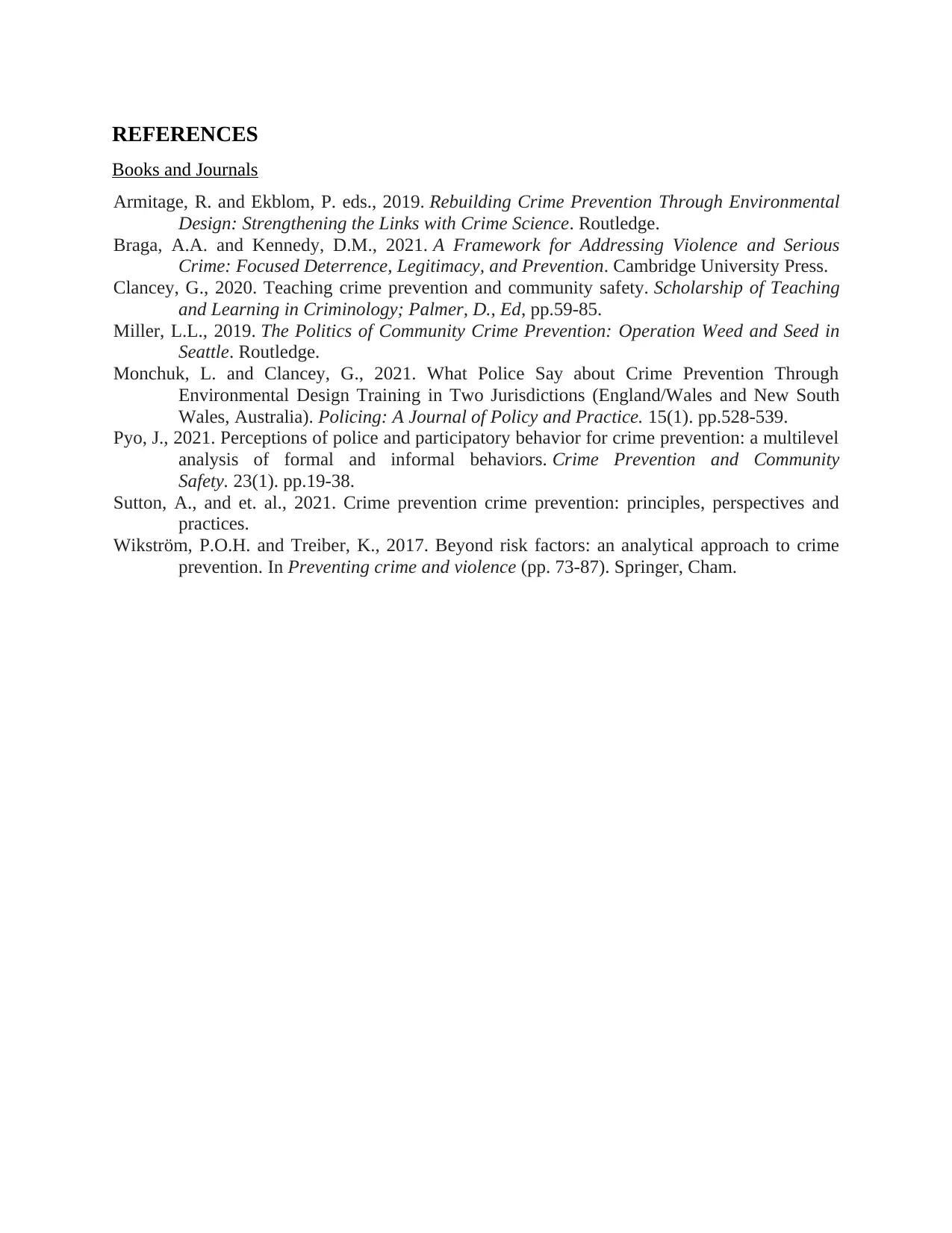
REFERENCES
Books and Journals
Armitage, R. and Ekblom, P. eds., 2019. Rebuilding Crime Prevention Through Environmental
Design: Strengthening the Links with Crime Science. Routledge.
Braga, A.A. and Kennedy, D.M., 2021. A Framework for Addressing Violence and Serious
Crime: Focused Deterrence, Legitimacy, and Prevention. Cambridge University Press.
Clancey, G., 2020. Teaching crime prevention and community safety. Scholarship of Teaching
and Learning in Criminology; Palmer, D., Ed, pp.59-85.
Miller, L.L., 2019. The Politics of Community Crime Prevention: Operation Weed and Seed in
Seattle. Routledge.
Monchuk, L. and Clancey, G., 2021. What Police Say about Crime Prevention Through
Environmental Design Training in Two Jurisdictions (England/Wales and New South
Wales, Australia). Policing: A Journal of Policy and Practice. 15(1). pp.528-539.
Pyo, J., 2021. Perceptions of police and participatory behavior for crime prevention: a multilevel
analysis of formal and informal behaviors. Crime Prevention and Community
Safety. 23(1). pp.19-38.
Sutton, A., and et. al., 2021. Crime prevention crime prevention: principles, perspectives and
practices.
Wikström, P.O.H. and Treiber, K., 2017. Beyond risk factors: an analytical approach to crime
prevention. In Preventing crime and violence (pp. 73-87). Springer, Cham.
Books and Journals
Armitage, R. and Ekblom, P. eds., 2019. Rebuilding Crime Prevention Through Environmental
Design: Strengthening the Links with Crime Science. Routledge.
Braga, A.A. and Kennedy, D.M., 2021. A Framework for Addressing Violence and Serious
Crime: Focused Deterrence, Legitimacy, and Prevention. Cambridge University Press.
Clancey, G., 2020. Teaching crime prevention and community safety. Scholarship of Teaching
and Learning in Criminology; Palmer, D., Ed, pp.59-85.
Miller, L.L., 2019. The Politics of Community Crime Prevention: Operation Weed and Seed in
Seattle. Routledge.
Monchuk, L. and Clancey, G., 2021. What Police Say about Crime Prevention Through
Environmental Design Training in Two Jurisdictions (England/Wales and New South
Wales, Australia). Policing: A Journal of Policy and Practice. 15(1). pp.528-539.
Pyo, J., 2021. Perceptions of police and participatory behavior for crime prevention: a multilevel
analysis of formal and informal behaviors. Crime Prevention and Community
Safety. 23(1). pp.19-38.
Sutton, A., and et. al., 2021. Crime prevention crime prevention: principles, perspectives and
practices.
Wikström, P.O.H. and Treiber, K., 2017. Beyond risk factors: an analytical approach to crime
prevention. In Preventing crime and violence (pp. 73-87). Springer, Cham.
1 out of 8
Related Documents
Your All-in-One AI-Powered Toolkit for Academic Success.
+13062052269
info@desklib.com
Available 24*7 on WhatsApp / Email
![[object Object]](/_next/static/media/star-bottom.7253800d.svg)
Unlock your academic potential
Copyright © 2020–2025 A2Z Services. All Rights Reserved. Developed and managed by ZUCOL.





